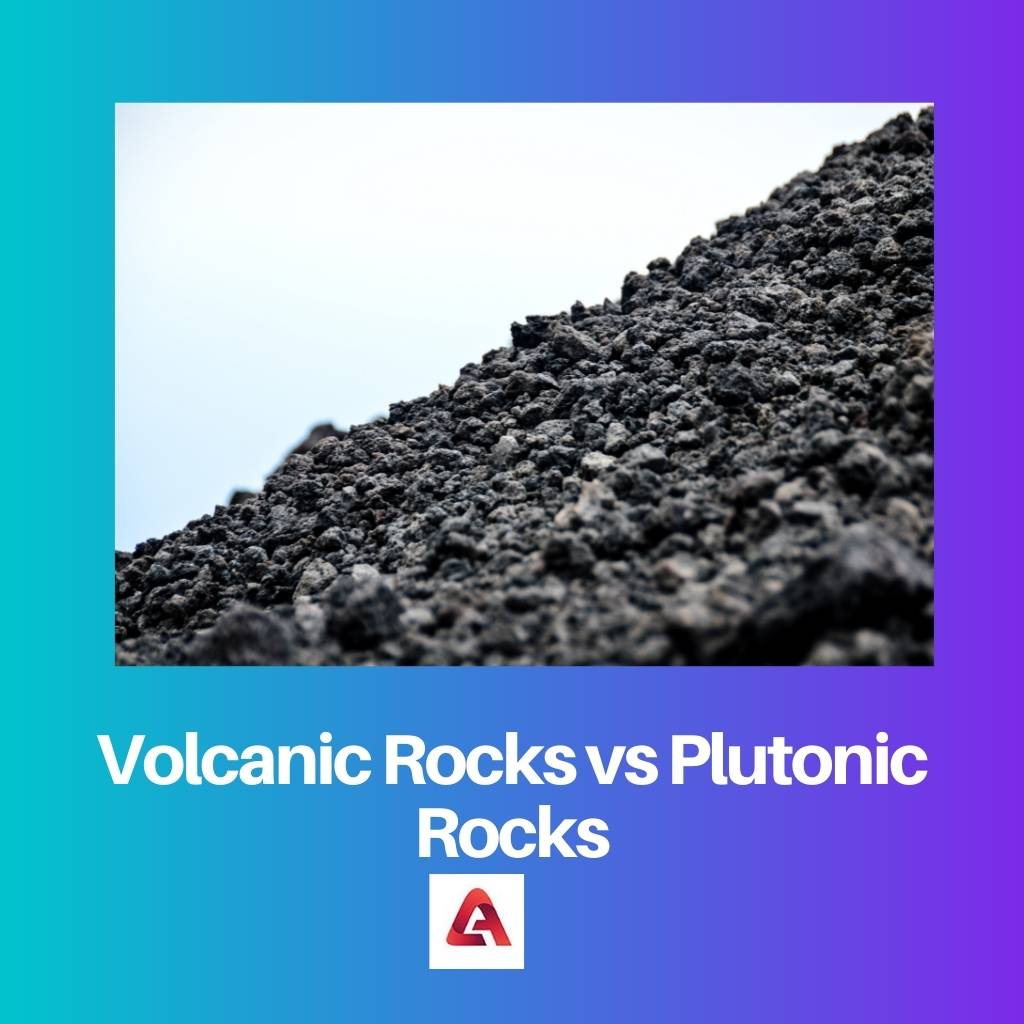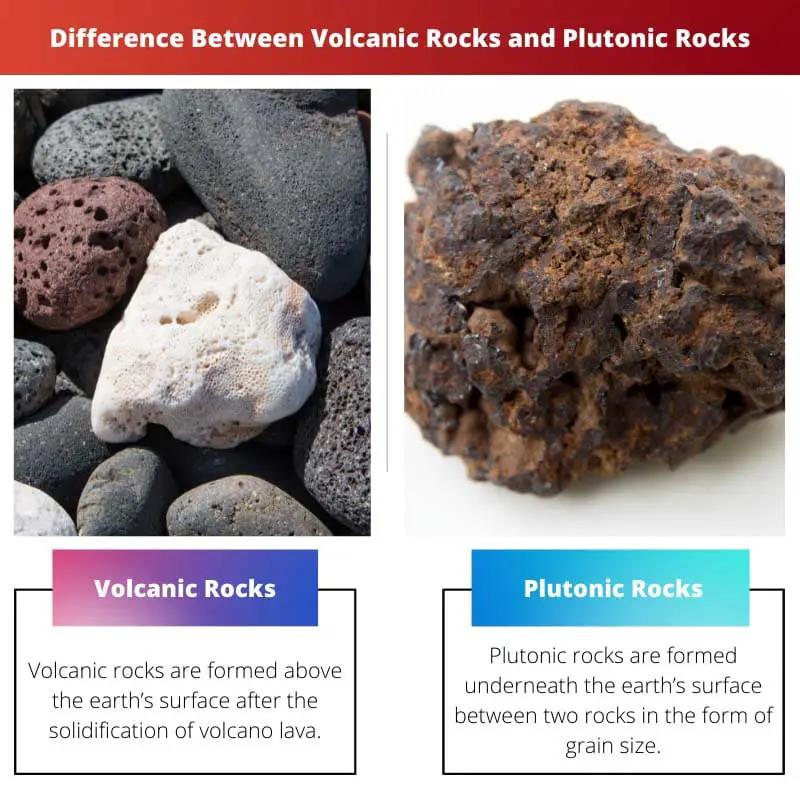Rocks are formed naturally as a solid mass that includes natural materials for their formation and texture that further divides into being organic and inorganic.
Such rocks exclusively take the shape of Volcanic rocks and Plutonic rocks, which differ from each from many aspects despite being the descendant of the same line. Their differences begin with their composition level.
Key Takeaways
- Volcanic rocks are formed from lava that has cooled and solidified on or near the Earth’s surface, while plutonic rocks are formed from magma that has cooled and solidified deep beneath the Earth’s surface.
- Volcanic rocks have smaller crystals and are more porous than plutonic rocks.
- Plutonic rocks are more coarse-grained and have larger crystals than volcanic rocks.
Volcanic Rocks vs Plutonic Rocks
Volcanic rocks, also known as extrusive rocks, are formed when magma or lava erupts onto the Earth’s surface and cools quickly, causing it to have a fine-grained texture. Plutonic rocks, also known as intrusive rocks, are formed when magma cools and solidifies below the Earth’s surface.

Volcanic rocks are formed above the ground. When there is a volcanic eruption, and its hot lava touches the earth’s ground or surface, it leads to the formation of volcanic rocks.
This lava undergoes the process of solidification, where the lava cools down and forms crystals which further form the fine-grained rocks out of a volcanic eruption.
The lava cools down quickly but forms crystals as long as the heat is evoked from the chest of the volcano.
Plutonic rocks undergo the process of formation underground, somewhere deep under the earth’s surface, through pressure and process. They are a type of igneous rock that comes across as grain-sized efficiency.
The formation of plutonic rocks is one step ahead of volcanic rocks. They are formed when hot volcanic lava is inserted between other rocks pressured under the depth of the earth’s surface.
Comparison Table
| Parameter of Comparison | Volcanic Rocks | Plutonic Rocks |
|---|---|---|
| Formation | Volcanic rocks are formed above the earth’s surface after the solidification of volcano lava. | Plutonic rocks are formed underneath the earth’s surface between two rocks in the form of grain size. |
| Colour | It is dark and smoky in color. | It is dark grey in color. |
| Mineral Content | Volcanic rocks contain high mineral content. | Plutonic rocks contain low mineral content. |
| Formation speed | The lava cools very quickly from the volcanic rocks. | The magma cools very slowly and hence plutonic rocks. |
| Examples | Basalt, Pumice. | Granite, Gabbro. |
What are Volcanic Rocks?
Volcanic rocks are termed igneous rocks especially found in volcanic regions across the world. Their texture is glassy and fine-grained and is formed through the process of solidification of a volcanic eruption.
When there is a volcanic eruption in the active volcanic regions, a hot liquid magma called lava is evoked and flows down from the volcano, which cools down very fast when it hits the earth’s surface, making crystallized rocks called volcanic rocks.
As mentioned, the term volcanic rocks are derived from their composition process. Basalt is one common example of volcanic rock and has very low silica content in it.
The rocks are said to have a vesicular texture which refers to the voids of the volatiles from the result of molten lava on the earth’s surface.
The volcanic rocks are not all the same, some across as heavy while some can be lightly weighted as well. It depends on the texture, composition, and molten lava contents.
Volcanic rocks are studied based on their texture, chemistry, mineralogy, and composition to know about their formation process, silica content along with other minerals content and the texture they are built, and how they can be useful for people.
The mechanical behavior of volcanic rocks is said to be complex depending on their microstructure inside.

What are Plutonic Rocks?
Plutonic rocks are also types of igneous rocks in the history of the rock formation family. They are formed with solidification at a great depth under the earth’s surface.
They are formed from the magma before it transforms into lava and contains many minerals and metals like gold and lead, which rise and force in between old rocks inside.
Unlike volcanic rocks, they cool very slowly under the depth of the earth’s surface or crust.
This slow process of cooling the magma between the rocks allows the individual rock crystals to grow into large bullock structures, which form coarse-grained rock.
These rocks are later exposed when there is volcanic eruption or erosion. Many plutonic rocks are formed in the cooling process, which takes more than thousands of years.
Plutonic rocks are tightly packed or coarse-grained in medium size with a dark grey texture and color, distinguishing them from volcanic rocks outside the earth’s surface.
Plutonic rocks are the most common type of rocks found on Earth due to their formation contents and livelihood under the roots of many mountain ranges. They are formed from the mixture of various minerals found naturally at the earth’s depth.

Main Differences Between Volcanic Rocks and Plutonic Rocks
- Volcanic rocks are formed above the earth’s surface, whereas plutonic rocks are formed underneath the earth’s surface in the earth’s crust.
- Volcanic rocks are formed through the solidification of volcanic lava, whereas plutonic rocks are formed through the process of solidification of magma.
- Volcanic rocks are formed very fast when the lava cools down, whereas plutonic rocks take thousands of years to cool down to form the rocks.
- Volcanic rocks are formed with the help of air when it is exposed, whereas plutonic rocks can be formed without the exposure of air and with the pressure of the earth’s surface.
- Volcanic rocks have a glassy texture along with a dark color, whereas plutonic rocks have a rough texture with a dark grey color.

- https://www.sciencedirect.com/science/article/pii/0009254180900200
- https://link.springer.com/article/10.1007/BF01820841

The article provides a comprehensive overview of the formation, texture, and mineral content of volcanic and plutonic rocks. The comparisons are elucidating and insightful.
The article’s emphasis on the geological processes and composition differences between volcanic and plutonic rocks greatly enriches our understanding of these rock formations.
The article is a well-structured, engaging piece that delves into the intricate details of volcanic and plutonic rocks. It’s a commendable effort to educate readers about these geological phenomena.
The article provides a comprehensive and enlightening comparison between volcanic rocks and plutonic rocks. The key differences in their formation, texture, composition level are clearly outlined. It’s a great read for anyone interested in geology.
I completely agree with your assessment. The details provided in the article are indeed rich and thorough, making it easy for readers to understand the concept of these rocks.
The scientific aspect of the article is impressive, and the comparison table really helps in visualizing the disparities between volcanic and plutonic rocks. It’s a valuable resource for students and professionals alike.
The in-depth explanation of the formation process and the detailed comparison between volcanic and plutonic rocks makes this article an excellent resource for geology enthusiasts and researchers.
I agree. The scientific insights provided in the article are commendable, and the clarity of presentation enhances the educational value of the piece.
The article succinctly explains the formation process of both volcanic and plutonic rocks, shedding light on their respective characteristics and geological significance.
The detailed explanation about the mineral content and the formation speed of these rocks is particularly fascinating. It deepens our understanding of these geological formations.
The article effectively captures the nuances of volcanic and plutonic rock formations, offering valuable information to readers interested in gaining a deeper understanding of geology.
The comparison table is a fantastic addition to the article, presenting key characteristics in a concise manner. The article effectively educates readers about the distinctions between volcanic and plutonic rocks.
The description of volcanic rocks and plutonic rocks is exceptionally detailed, making it an informative piece for those interested in the field of geology.
I appreciate the clarity with which the article delineates the differences between volcanic and plutonic rocks. It’s a compelling piece that adds to our knowledge of geology.
The emphasis on the mechanical behavior of volcanic rocks and the slow cooling process of plutonic rocks provides valuable insights into these geological phenomena.
The article’s in-depth analysis and emphasis on the differences in the formation speed and color of volcanic and plutonic rocks make it an intellectually stimulating read.
Indeed, the article offers a comprehensive insight into the geological properties and formation processes of volcanic and plutonic rocks, catering to a wide audience interested in earth sciences.
The detail and clarity with which the article presents the distinctions between volcanic and plutonic rocks reflect the high intellectual caliber of the content, making it a valuable reference material.
The article’s delineation of the texture, mineral content, and examples of volcanic and plutonic rocks is both illuminating and enriching for readers keen on understanding the geological realm.
The scientific precision and succinct articulation of the article heighten its educational value, providing readers with a broad and comprehensive understanding of volcanic and plutonic rocks.
The article offers a compelling analysis of volcanic and plutonic rocks, effectively encapsulating the scientific intricacies and distinct characteristics of these geological formations.